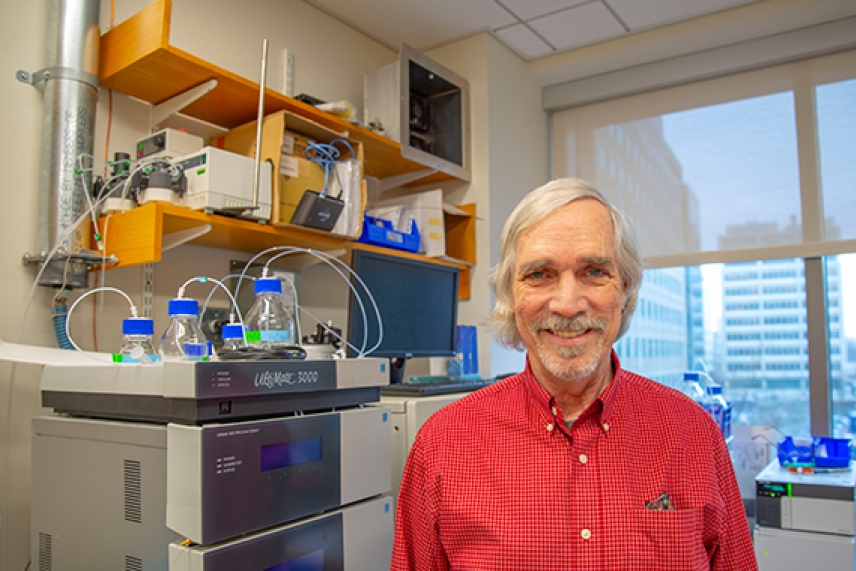
Proteomics Core Facility Director Eric Spooner
Conor Gearin/Whitehead Institute
Eric Spooner: Proteomics Core Facility
Eric Spooner knows his way around a protein. “I started in this field before proteomics became a word,” he says. With over 20 years of experience with analyzing proteins, most of that as facility manager of the Proteomics Core Facility at Whitehead Institute, Spooner aids researchers looking to measure protein levels in cells, figure out how a complex fits together, or evaluate how different proteins interact with each other and their surroundings.
Though there are tools for looking at RNA transcripts to measure gene expression, Spooner says it’s often important to go all the way to protein levels to know what’s really going on in the cell. “The quantities don’t always match up between the levels of RNA in the cell and the proteins in the cell,” he says. “There’s protein turnover that occurs. Some proteins are long-lived, some are short-lived.”
What’s more, many drugs affect their targets by changing a protein’s shape. “If you can add a drug that latches onto a protein and changes its 3D structure to where it can’t do its job efficiently anymore, that would never show up in the RNA transcripts,” he says.
For measuring relative levels of a protein in a treated group of cells compared to a control group, Spooner uses techniques such as SILAC or iTRAQ that involve labelling amino acids or peptides with isotopes of carbon or nitrogen that have an extra neutron (13C and 15N). A high-resolution mass spectrometer lets him measure the relative difference between the treated and untreated cells.
The Proteomics Core’s set of mass spectrometry tools let researchers tease out questions about what happens to proteins after the RNA transcript is translated into a sequence of peptides. Many proteins undergo post-translational processing in which peptides are added or taken away. Spooner can also use a cross-linking analysis to figure out how the different subunits of a protein complex fit together. “It goes hand-in-hand with X-ray diffraction analysis for protein structure,” he says.
Spooner appreciates the collegial atmosphere at Whitehead Institute. “I like that I have the independence to kind of run my own show here,” he says. “I’m trusted to make good decisions and keep the core running. There’s no rigorous protocol that they have to follow to come and talk to me. That’s just how I like to run things.”
Many of the administrative hurdles faced by larger institutions don’t exist here, he says. “It’s a lot easier here, because we all know each other,” he says. “At a larger place, you’re just another name on a list.”
Spooner is a music fan and a sustaining member of WERS, the Emerson College independent radio station that he usually tunes into in the lab. Lately, he and his wife has gone to shows by blues and rock musicians including Joe Bonamasa and Dweezil Zappa, Broadway star Barbra Streisand, and the jazz vocal group Manhattan Transfer. He recently moved from Somerville to Dorchester, and has been exploring the restaurant scene in his new neighborhood.
Topics
Contact
Communications and Public Affairs
Phone: 617-452-4630
Email: newsroom@wi.mit.edu


